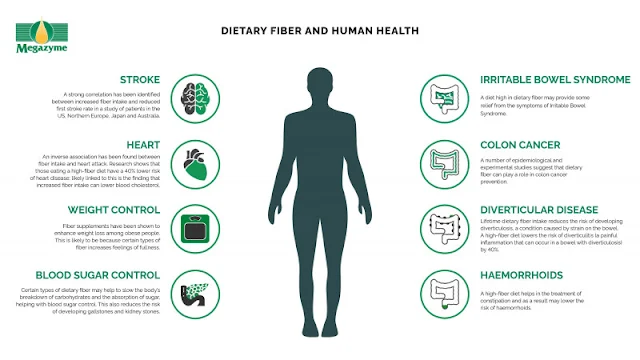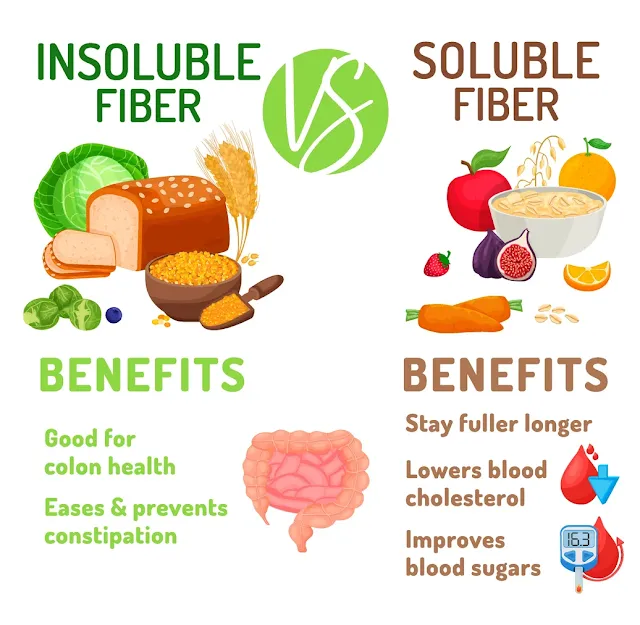Do you start your day with a bowl of oatmeal or a slice of whole grain toast? Do you snack on fruits, vegetables, and nuts throughout the day? If so, you're already getting a healthy dose of an important nutrient - dietary fiber.
Dietary fiber is a type of carbohydrate that our bodies can't fully digest. Though we don't get any calories from fiber, it plays a vital role in our health and wellbeing. Let's explore why we need dietary fiber, what are the best sources, and how much we should aim for each day.
Why Is Fiber So Important?
Dietary fiber provides some major health benefits that make it an essential part of our daily diet:
Supports Digestive Health
Fiber adds bulk to our stools and helps food move smoothly through the digestive tract. This prevents constipation and improves regularity (1). Soluble fiber soaks up water in the intestines to form a gel-like consistency. This allows stools to pass easily. Insoluble fiber adds bulk and aids in timely elimination.
Overall, getting enough fiber helps maintain digestive health and prevent uncomfortable problems like hemorrhoids.
Promotes Heart Health
Soluble fiber has been shown to lower LDL or "bad" cholesterol levels in the blood (2). It binds to cholesterol molecules and escorts them out of the body before they can clog up arteries. A diet high in fiber, especially soluble fiber, reduces the risk of heart disease.
Aids Weight Management
Foods high in fiber tend to be more filling and satiating. The bulk and volume fiber adds makes you feel full faster and for longer (3). This naturally curbs appetite and decreases calorie intake. Adding more high-fiber foods is an effective way to manage weight.
Regulates Blood Sugar
The American Diabetes Association recommends a high-fiber diet for better blood sugar control (4). Soluble fiber slows down the breakdown of carbohydrates and the absorption of sugar, preventing spikes and dips in blood glucose levels.
Provides Immune Support
Fiber feeds the good bacteria in our gut microbiome. A healthy gut flora strengthens immunity and prevents growth of harmful bacteria (5). The short-chain fatty acids created when gut bacteria ferment fiber also boost immunity.
Clearly, fiber is not just for digestive regularity. It’s a nutrient that benefits total body health. But what exactly counts as a good fiber source?
The Best Food Sources of Dietary Fiber
Dietary fiber is only found in plant foods like fruits, vegetables, whole grains, nuts, seeds, and legumes. Here are some of the top foods loaded with fiber:
Fruits and Vegetables
Berries, citrus fruits, apples, pears, bananas, broccoli, artichokes, green peas, sweet potatoes, and carrots are all high in fiber. Going for produce with edible skins and seeds ups the fiber content.
Some specific examples:
- Raspberries (8g per cup)
- Figs (5g per fruit)
- Artichokes (10g per medium artichoke)
- Split peas (16g per cooked cup)
- Baked sweet potatoes with skin (4g per medium potato)
Whole Grains
Choose 100% whole grain breads, cereals, pasta, brown rice, quinoa, oats, and barley as fiber-rich alternatives to processed grains.
Some tasty options:
- Oatmeal (4g per cooked cup)
- Popcorn (3g per 3 cups)
- Whole grain pasta (6g per cooked cup)
- Brown rice (3.5g per cooked cup)
- Whole grain bread (2-3g per slice)
Beans, Lentils and Legumes
Kidney beans, edamame, lentils, chickpeas, and other legumes are loaded with fiber. Enjoy them in soups, salads, curries, or veggie burgers.
Some great picks:
- Lentils (16g per cooked cup)
- Black beans (15g per cooked cup)
- Baked beans (10g per half cup)
- Edamame/soybeans (9g per cooked cup)
Nuts and Seeds
Almonds, pistachios, walnuts, chia seeds, flaxseeds, and hemp seeds pack a fiber punch. They add crunch and nutrients to smoothies, yogurt, oatmeal, and salads.
Grab a handful of:
- Almonds (4g per ounce)
- Chia seeds (10g per ounce)
- Flaxseeds (8g per ounce)
- Sunflower seeds (3g per ounce)
When shopping, compare nutrition labels and choose options higher in fiber. Go for whole foods over processed products.
Now that you know where to find it, how much fiber should you aim for daily?
Recommended Daily Intake of Fiber
The general daily recommendation is 25-30 grams of fiber for adults (6). That’s about the amount in 1 cup beans + 2 apples + 1⁄2 cup oatmeal + 1⁄4 cup almonds.
However, most Americans only get about half the recommended amount (7). Bumping up your fiber intake provides major benefits but should be done gradually to avoid gas or bloating. Also drink plenty of water.
Here are some tips to safely increase your fiber intake:
- Start your day with a high fiber breakfast like oatmeal or whole grain cereal
- Add beans, lentils or chickpeas to your salads and grain bowls
- Snack on fruits and nuts throughout the day
- Switch to whole grain bread and pasta
- Throw greens like spinach into smoothies
- Eat the edible skins of fruits and veggies
- Choose brown rice and quinoa over white varieties
- Gradually increase high fiber foods over 2-3 weeks
When Fiber Supplements Can Help
If getting enough fiber from whole foods is challenging, consider a fiber supplement like psyllium husk or methylcellulose. Always start with small doses and increase slowly.
Fiber supplements add bulk to stools and can help with:
- Constipation
- IBS symptoms
- Diverticulosis
- Hemorrhoids
- Cholesterol management
Speak to your doctor to see if a supplement makes sense for your individual health needs.
Too Much of a Good Thing?
With all the benefits of fiber, can you ever get too much? Consuming very high amounts can potentially cause abdominal pain, diarrhea, and nutrient deficiencies.
The upper limit is typically placed at around 50 grams of fiber per day (8). Above this, side effects tend to occur. It’s quite challenging to reach this level through everyday foods alone. But if taking fiber supplements, be mindful of overall intake from all sources.
Fiber Checklist for Better Health
Fiber is clearly an essential nutrient that offers digestive, weight loss, heart health, immune and blood sugar benefits. Follow these tips to make sure you get enough:
✓ Eat a range of high fiber fruits, vegetables, whole grains, nuts and legumes
✓ Aim for 25-30 grams of fiber per day
✓ Increase fiber foods gradually to allow your body to adjust
✓ Stay hydrated and drink water throughout the day
✓ Consider a supplement if needed for extra fiber intake
✓ Don’t overdo it - excessive fiber causes side effects
✓ Compare food labels and choose higher fiber options
With some mindful tweaks to your diet, getting enough daily fiber is totally achievable. Your digestive system and overall health will thank you!
References:
- https://www.ncbi.nlm.nih.gov/pmc/articles/PMC6124841/
- https://www.hsph.harvard.edu/nutritionsource/fiber/
- https://academic.oup.com/ajcn/article/79/5/899S/4690379
- https://www.diabetes.org/healthy-living/recipes-nutrition/understanding-carbs/fiber
- https://www.ncbi.nlm.nih.gov/pmc/articles/PMC6137675/
- https://www.mayoclinic.org/healthy-lifestyle/nutrition-and-healthy-eating/in-depth/fiber/art-20043983
- https://www.ars.usda.gov/ARSUserFiles/80400530/pdf/DBrief/12_fiber_intake_0910.pdf
- https://ods.od.nih.gov/factsheets/DietaryFiber-Consumer/
Frequently Asked Questions About Dietary Fiber
What are some easy ways to add more fiber to my diet?
There are small, simple changes you can make to increase your daily fiber intake:
- Choose whole grain bread, pasta, cereal, brown rice and oats instead of refined/white varieties
- Add beans, lentils or chickpeas to salads, soups and grain bowls
- Snack on fruits like apples, pears, berries
- Throw a handful of nuts like almonds or walnuts into yogurt or oatmeal
- Opt for sweet potatoes over white potatoes
- Add greens like spinach to smoothies
- Eat the edible skins of fruits and vegetables
Gradually increasing high-fiber foods over 2-3 weeks allows your body to adjust and prevents digestive issues.
How do I know if I'm getting enough fiber each day?
The recommended daily fiber intake is 25-30 grams. Reading nutrition labels helps identify foods high in fiber. As a guideline:
- 1 medium apple or 1 cup berries: 4-5 grams
- 1 medium baked sweet potato with skin: 4 grams
- 1/2 cup cooked beans or lentils: 7-8 grams
- 1 slice 100% whole wheat bread: 2-3 grams
- 1/2 cup oatmeal: 2 grams
- 1 ounce almonds: 4 grams
Track your fiber intake for a few days. If consistently low, aim to incorporate more fruits, vegetables, whole grains, beans, nuts and seeds. Supplements can also help fill fiber gaps.
What if I experience gas or bloating after increasing fiber?
It's normal to experience some abdominal discomfort when ramping up fiber intake. Here are some tips to help minimize symptoms:
- Increase high-fiber foods gradually over 2-3 weeks
- Drink plenty of water to help move fiber through the digestive tract
- Limit gassy foods like cabbage, broccoli, dairy, soda
- Consider an over-the-counter remedy like Beano
- Exercise regularly to speed up digestion
- Reduce intake of excess sugar and fat
- Look for signs of fiber intolerance like diarrhea
If gas and bloating persist, speak with your doctor. You may need to modify sources and amounts of fiber.
How does fiber help with weight loss?
Fiber's weight loss benefits come in several forms:
- Adds bulk and increases satiety so you feel fuller on fewer calories
- Balances blood sugar and insulin to curb cravings
- Binds to fat and cholesterol and eliminates them from the body
- Slows digestion which stabilizes energy and hunger levels
- Provides few calories so high-fiber foods facilitate calorie deficit
To leverage fiber for weight loss:
- Eat fiber-rich foods like oatmeal, fruits, vegetables and beans
- Drink water before meals
- Choose whole grains over processed carbs
- Increase fiber intake gradually to prevent adverse effects
- Combine with exercise and healthy fats & protein
Prioritizing fiber brings prolonged satiety so you eat less and lose weight.
Does taking fiber supplements have any risks?
Fiber supplements like psyllium husk and methylcellulose are generally safe if used properly. However, potential side effects include:
- Gas, bloating, diarrhea if ramped up too quickly
- Abdominal pain from excess fiber intake
- Allergic reaction or trouble swallowing for some individuals
- Reduced absorption of certain medications taken at same time
- Intestinal blockage if taking a concentrated supplement without enough water
Speak with a doctor before taking supplements, especially if you have any medical conditions or take prescribed medicines. Start with low doses, increase slowly, and stay adequately hydrated.






0Comments